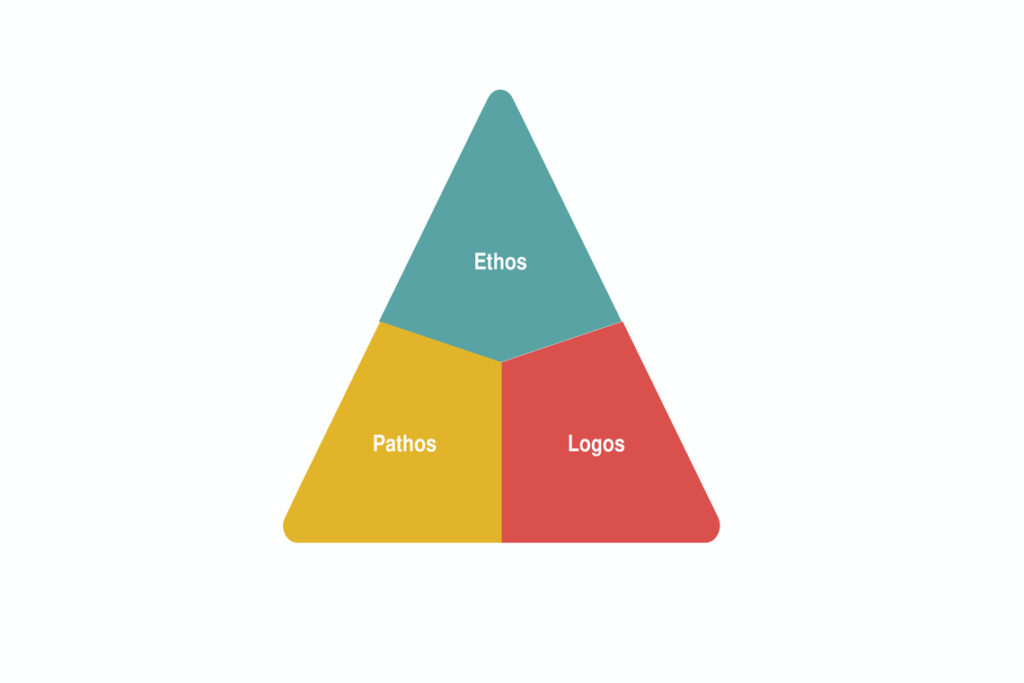Disclaimer: We sometimes use affiliate links in our content. For more information, visit our Disclaimer Page.
The peripheral route of persuasion is getting someone to do something they may not want to do at first. It relies on factors such as credibility, likability, and emotional appeal.
In this blog post, we will discuss the peripheral route of persuasion in detail and provide you with everything you need to know to use it effectively!
What is the peripheral route of persuasion?
The social psychology phenomenon known as the peripheral route of persuasion occurs when people are persuaded by something other than the central argument being made. This can happen when somebody is influenced by a celebrity endorsement, for example, or when they respond to an emotional appeal rather than logic. The peripheral route is often used in advertising, as it can more effectively induce a buying decision than presenting a rational argument.
While the central route of persuasion is based on logic and thoughtful consideration, the peripheral route relies on shortcuts and cues that can trigger a quick decision. In some cases, the peripheral route can lead to poor choices, but it can also be helpful when time is limited or detailed analysis is impossible.
Why is the peripheral route for persuasion effective?

The peripheral route to persuasion is based on peripheral cues, which are cues that are not related to the argument itself. Instead, they are based on factors such as the speaker’s attractiveness, the length of the message, and whether or not the audience is tired.
Because peripheral cues are not related to the argument itself, they can be easy to miss. However, research has shown that peripheral cues can still significantly impact whether or not an argument is persuasive.
For example, If the audience is taking the long road, longer messages are more convincing than shorter ones. This happens since the length of the message alone may be enough to persuade people. Similarly, if the audience is tired, they may be more likely to accept a message that is easy to process, such as a message with a simple structure or a clear conclusion.
In general, the peripheral route to persuasion is effective because it can take advantage of cues that the audience may not even be aware of.
What is the difference between central and peripheral routes to persuasion?
Two different routes can be taken when attempting to persuade someone. The central route relies on facts and logic to try and sway the person, while the peripheral route uses positive or negative cues to influence them.
The central route is more likely to be effective with things requiring thought, as the individual will likely go through all the information provided. On the other hand, the peripheral route can be helpful when trying to convince someone of something that doesn’t require a lot of thought.
This is because the central and peripheral cues will create an emotional response that can override logical thoughts. It’s important to note that both routes can be effective, depending on the situation.
Related: Central Route to Persuasion
What does it mean to persuade someone?
Persuading someone means convincing them of something. Depending on the situation, this can be done through peripheral and central routes.
The central route requires more effort to change someone’s beliefs or attitudes. On the other hand, the peripheral route is more about using cues to influence someone’s behavior.
Several factors can affect how successful you are in persuading someone. These include your credibility, the strength of your arguments, and the other person’s involvement in the issue.
What is the Elaboration Likelihood Model of Persuasion?
The Elaboration Likelihood Model (ELM) of persuasion is a two-stage paradigm for the change in attitudes. In 1980, Richard E. Petty and John Cacioppo created the ELM. The proposed model strives to explain how persuasive messages are processed, why they are utilized, and the impact of those messages on attitude change in different ways.
The elaboration likelihood model considers that there are two routes to persuasion: the central route and the peripheral route. The central route to persuasion is used when people are highly motivated to process a persuasive message deeply.
In contrast, the peripheral route to persuasion is used when people are not highly motivated to process a persuasive message deeply and thus rely on cues such as the physical attractiveness of the source or prestige to make a decision.
Evidence for the ELM comes from research on participants’ ability to recall persuasive messages and cognitive measures such as reaction time tasks. The model has also been used to explain various phenomena, such as attitude change, compliance, and social influence.
How to use the peripheral route of the persuasion model?

If you want to persuade someone using the peripheral route of persuasion, you need to focus on factors that are not directly related to the issue. For example, you might try to appeal to someone’s sense of social status or attractiveness. By contrast, if you use the central route of persuasion, you would focus on the merits of your argument.
The peripheral route of persuasion is often used in advertising, where marketers try to create an emotional connection with their audience. They do this by appealing to factors that are not directly related to the product, such as sex appeal or celebrity endorsements.
Steps involved in using the peripheral route of the persuasion model:
- Identify the target audience.
- Develop a message that is likely to appeal to the target audience.
- Third, make sure a credible source delivers the message.
- Fourth, use persuasive techniques that are likely to be effective with the target audience.
- Finally, monitor the response of the target audience to the message.
For Example:
Here is an example of how the peripheral route of persuasion can be used. Suppose you are trying to persuade people to vote for a particular candidate in an election. You would first identify the target audience. Then you would develop a message that will likely appeal to that target audience.
For example, you might emphasize the candidate’s experience and qualifications. Next, you would ensure a credible source delivers the message. Also, you can have the candidate give a speech or participate in a debate.
Finally, you would use persuasive techniques that are likely to be effective with the target audience. For example, you might use emotional appeals or offer rewards for voting.
Top 8 effective Persuasion Tactics

People use mental shortcuts to arrive at decisions quickly. For example, when you see a commercial for a new product, your brain automatically assumes that the product must be good if it’s being advertised.
However, this isn’t always the case. Advertisers use persuasive tactics to influence your opinion of their products. Some standard persuasion techniques include providing social proof, using authority figures, and appealing to emotion.
By understanding how these methods work, you can become more aware of the persuasive techniques used in your everyday life.
1. The Principle of Reciprocity
The principle of reciprocity is one of the most powerful persuasion tactics. It dictates that humans are wired to repay favors, whether large or small. Doing something nice for someone increases the chances that they’ll do something nice for you in return.
It can be used in both personal and professional relationships. For example, if you know someone always going out of their way to help you, you may feel compelled to return the favor.
Or, if you receive exceptional service from a business, you may be more likely to patronize them in the future. The bottom line is that we can increase our chances of receiving the same in return by being generous and helpful.
2. Get a foot in the door
The foot-in-the-door technique is a persuasion tactic that involves getting someone to agree to a small request before asking them to do something bigger. The method gets its name from the idea of putting your foot in the door to prevent it from being closed.
The logic behind the tactic is that if someone agrees to a small request, they are more likely to agree to a more significant request. As a result, the foot-in-the-door technique is often used by salespeople, fundraisers, and marketing research professionals.
It can be an effective way to get someone to say yes to your request, but it is vital to use it sparingly. If you overuse the technique, people will catch on, and you may lose credibility.
Social proof is a powerful weapon in any persuader’s arsenal. By simply showing that other people are doing something, we can often convince others to do the same. This is especially true when the people we’re showing are similar to our target audience.
When we see people like us doing something, it serves as a strong signal that it must be the right thing to do. As a result, social proof can be an extremely effective way to sway people’s opinions and behavior. When used judiciously, it can be a powerful tool for promoting any message or cause.
Trust is a fundamental human emotion essential for all kinds of relationships. When it comes to making decisions, we often look to those who we trust for guidance.
This is why authority figures play such an essential role in our lives. Whether it’s a parent, teacher, or doctor, we often defer to authority figures when it comes to making decisions. This is because we believe they have our best interests and know more than we do.
As a result, we are more likely to comply with their requests. This principle can also be applied to businesses and marketing. If you can position yourself or your product as an authority figure, you will more likely get people to comply with your requests. Establishing trust and demonstrating expertise can increase your chances of success.
5. Make it a game
Game theory is the study of strategic decision-making. It can be applied to various situations, from business competition to political conflict. And, as it turns out, game theory can also be used to convince people to do what you want them to.
The basic idea is simple: by making your request into a game, you can increase the likelihood that people will want to comply. After all, who doesn’t love games and competition? But, of course, there are many ways to turn a request into a game.
One popular approach is to offer prizes for compliance. For example, businesses often run contests where customers can win prizes for completing tasks (such as filling out a survey or visiting a store). Similarly, charities often use gamification to increase donations.
6. Be scarce
Whenever we believe something is scarce, we instinctively value it more highly. This is because scarcity taps into our deepest fear of missing out. So when we think that something might not be available for much longer, we panic and want to get our hands on it as soon as possible.
This is why sales and discounts are so effective. By creating a sense of urgency, businesses can convince us to buy things that we might not otherwise need or want.
7. Use anchored pricing
Anchored pricing is a persuasion tactic that involves starting with a high price and then discounting it to the desired price. By starting high, you make the final price seem like a bargain. This is an incredibly effective tactic when combined with scarcity.
For example, selling a limited edition item might start with a high price and then offer a significant discount. This would create a sense of urgency and encourage people to buy before the item runs out.
Anchored pricing can effectively boost sales, but it’s essential to use it sparingly so that customers don’t feel like they’re being taken advantage of.
8. Invoke expertise
As mentioned earlier, people often defer to authority figures when making decisions. This is because we believe that they have more expertise than we do.
As a result, one of the most effective persuasion tactics is to invoke your expertise. By positioning yourself as an expert, you can increase the likelihood that people will comply with your requests.
Of course, it’s essential to back up your claims of expertise with evidence. Otherwise, you risk coming across as arrogant or insincere. But if you demonstrate that you know what you’re talking about, people will be more likely to trust you and comply with your requests.
So there you have it. These are just a few tactics you can use to get people to say “yes.” The next time you need to convince someone of something, try using one of these strategies.
Related: Tactful Communication
What is the peripheral nervous system in psychology?
The peripheral nervous system (PNS) is the portion of the nervous system that consists of all the nerves and ganglia outside of the brain and spinal cord. The PNS is divided into two main divisions: the somatic nervous system and the autonomic nervous system. The somatic nervous system is responsible for carrying messages to and from the body’s voluntary muscles. In contrast, the autonomic nervous system controls the body’s involuntary functions, such as digestion, heart rate, and respiration.
The PNS also contains a third division, the enteric nervous system, which controls intestinal motility. Although the PNS is structurally and functionally distinct from the CNS, it is intimately connected to it via nerve fibers that pass through the brainstem and spinal cord.
These nerves allow two-way communication between the CNS and the PNS, allowing for reflexive responses to environmental changes and higher-order cognitive processes.
What is Yale Attitude Change Approach?

The Yale attitude change approach is based on the idea that people are more likely to change their attitudes in response to persuasive messages when they are motivated to do so and when the messages are credible. For example, during World War II, Hovland and his colleagues found that people were more likely to be persuaded by messages that were delivered by credible sources.
This finding led to the development of the source credibility model, which suggests that people are more likely to be persuaded by messages from sources they perceive as trustworthy and expert. In addition to source credibility, the Yale attitude change approach emphasizes the importance of message content and context.
For example, research has shown that people are more likely to be persuaded by messages containing relevant information. Similarly, the context in which a message is presented can influence its effectiveness. For instance, messages presented in a positive light are more likely to be effective than those shown in a negative light.
Overall, the Yale attitude change approach provides a comprehensive framework for understanding how persuasive messages can lead to attitude change.
What is a persuasive central route argument?
Using the central route can make an argument more compelling when persuading others. This is done by creating a strong and logical case that is hard to refute. The goal is to get the audience to see things from your perspective and change their attitude or behavior.
This type of persuasion is more likely to have a lasting effect than simply trying to appeal to emotions. Additionally, arguments that use the central route are less likely to be met with resistance since they are based on logic and facts. When used correctly, the central route can be a powerful tool for convincing others to see things your way.
Related: Communicate Assertively
What are the Three Elements of Persuasion?

Persuasion is not just about convincing someone to do something. It’s about using the right mix of logic and emotion to get them to see things your way. And that means understanding the three elements of persuasion: logos, pathos, and ethos.
1. Logos
A well-constructed argument must be built upon a foundation of clear and logical reasoning. This process of building an argument is known as logos, one of the essential elements of persuasive speaking. To persuade your audience, you must first provide them with a clear and logical progression of ideas.
Each point must flow smoothly from the last, forming a cohesive chain of reasoning. Only then can you hope to achieve a truly successful outcome. Remember that your audience will constantly evaluate your argument for soundness of logic. If you can provide them with a clear and well-reasoned case, you will likely win them over to your point of view.
2. Pathos
Pathos is the emotional content of your presentation. It is the most important because it is only when you move people at an emotional level that you can motivate them to change their thinking and take a particular action.
They can be created using stories, humor, images, music, or any other element that makes an emotional connection with your audience. When used effectively, pathos can be a powerful tool for persuasion.
However, it is important to use pathos sparingly and only when it is appropriate for the message you are trying to communicate. Overusing pathos can create an adverse reaction in your audience and undermine your credibility.
3. Ethos
Ethos is one of the three main modes of persuasion, along with pathos and logos. Put simply; ethos refers to your credibility as a speaker. The more credible you are, your audience will likely accept your arguments. There are several ways to increase your ethos.
First, you can establish your expertise on the topic at hand by sharing your qualifications and experience. Second, you can build trust with your audience by behaving professionally and ethically.
Finally, you can demonstrate your sincerity by speaking passionately about your beliefs. By increasing your ethos, you can become a more persuasive speaker and significantly impact your audience.
So overall, the best persuasion contains all three elements. That’s because people don’t make decisions solely on logic. They also consider emotion and ethics. So if you want to persuade someone, you need to appeal to all three.
Related: Rhetorical Strategies
Final Thoughts
That’s all there is to it! The peripheral route of persuasion is a powerful tool that you can use to increase sales and conversions. By understanding how this process works, you can create ads, content, and offers that are more likely to be persuasive.
Have you tried any of these techniques? We would love to hear about your experiences in the comment section below.
FAQ
Who discussed the term peripheral route to persuasion?
Richard Petty and John Cacioppo first discussed the peripheral route to persuasion. According to Petty and Cacioppo, there are two methods by which people can be persuaded: peripherally or centrally.
What are peripheral cues in psychology?
Peripheral cues are images or phrases that try to catch someone’s attention by implying something good. For example, central values, personal gains, and a popular celebrity can all be peripherally cued in a more basic sense. These cues are frequently utilized in marketing since they may successfully influence people to change their attitudes or actions.
On the other hand, they are a source of contention among both consumers and providers. They’re frequently accused of being manipulative and unethical, although they can be pretty valuable in influencing people’s beliefs and behaviors.
What are peripheral cues examples?
Peripheral cues examples are the cues we take in from our peripheral vision. They help us process information quickly without thinking too deeply about it. For example, if you see a person you find attractive, your brain will automatically start to process information about them before you have even thought about it.
This is why peripheral cues can be so powerful – they can influence our decisions and actions without us even realizing it. That said, not all peripheral cues are created equal. Some, like the perceived credibility or attractiveness of the source, are more influential than others.
What is a low level of elaboration?
As the name suggests, low elaboration or peripheral route processing means giving less thought to the matter. The processing is more superficial and usually happens when we lack motivation or interest in the task.
For example, you might skim through a how-to article without trying to understand and remember the steps. In contrast, high elaboration would involve reading carefully and trying to commit the instructions to memory.
When designing, users are more likely to take the low elaboration route when they find the task unimportant or difficult. To prevent this, designers must ensure that their designs are intuitive and easy to use. Otherwise, users will simply give up and move on to something else.
What is peripheral advertising?
Peripheral marketing is a less direct advertising approach that instead places ads on the periphery of life and lets them speak for themselves. By being more subtle, peripheral marketing hopes to make a bigger impact on the consumer.
This approach can take many forms, but some common examples include product placement in movies and TV shows, ads on public transportation, and sponsorship of events. While peripheral marketing can be an effective way to reach consumers, it can also be more expensive than other forms of advertising. Therefore, companies must carefully consider their target audience and objectives before using peripheral marketing.
What is peripheral decision-making?
When we are faced with a persuader, we can respond in one of two ways: the central route or the peripheral route. In the central route of persuasion, we take the time to process all the information being presented to us before making a decision. Then, we carefully weigh the pros and cons and consider all sides of the issue.
On the other hand, in peripheral route persuasion, decisions are made much more quickly, based on easy-to-process cues such as attractiveness, vocabulary, and emotions. Proponents of this approach argue that it can be just as effective as the central route, if not more so.
Thanks for reading!





